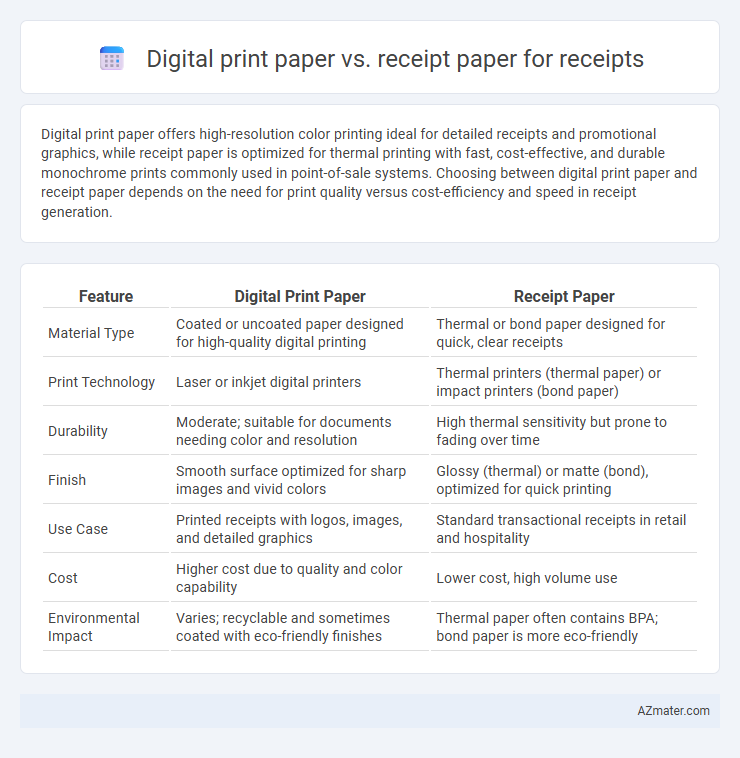Digital print paper offers high-resolution color printing ideal for detailed receipts and promotional graphics, while receipt paper is optimized for thermal printing with fast, cost-effective, and durable monochrome prints commonly used in point-of-sale systems. Choosing between digital print paper and receipt paper depends on the need for print quality versus cost-efficiency and speed in receipt generation.
Table of Comparison
| Feature | Digital Print Paper | Receipt Paper |
|---|---|---|
| Material Type | Coated or uncoated paper designed for high-quality digital printing | Thermal or bond paper designed for quick, clear receipts |
| Print Technology | Laser or inkjet digital printers | Thermal printers (thermal paper) or impact printers (bond paper) |
| Durability | Moderate; suitable for documents needing color and resolution | High thermal sensitivity but prone to fading over time |
| Finish | Smooth surface optimized for sharp images and vivid colors | Glossy (thermal) or matte (bond), optimized for quick printing |
| Use Case | Printed receipts with logos, images, and detailed graphics | Standard transactional receipts in retail and hospitality |
| Cost | Higher cost due to quality and color capability | Lower cost, high volume use |
| Environmental Impact | Varies; recyclable and sometimes coated with eco-friendly finishes | Thermal paper often contains BPA; bond paper is more eco-friendly |
Introduction to Digital Print Paper and Receipt Paper
Digital print paper is designed for high-resolution printing and vibrant color reproduction, making it ideal for marketing materials and detailed receipts. Receipt paper, often thermal or carbonless, is specifically engineered to provide clear, fast-drying prints suited for point-of-sale transactions. Both paper types cater to distinct printing technologies and usage requirements, affecting the durability and readability of printed receipts.
Understanding the Key Differences
Digital print paper offers high-resolution printing with vibrant colors and sharp images, making it ideal for detailed receipts requiring logos or graphics. Receipt paper, typically thermal or plain bond paper, prioritizes speed and cost-efficiency for fast, monochrome printing in retail or hospitality settings. Understanding these distinctions helps businesses select the right paper type to balance quality, durability, and printing technology compatibility.
Material Composition Comparison
Digital print paper typically consists of high-quality, smooth cellulose fibers coated with a polymer layer that enhances print clarity and durability for detailed images and text. Receipt paper, often thermal, contains a heat-sensitive coating composed of leuco dyes and developers that react to thermal print heads without needing ink. The fundamental material difference lies in the coating technology: digital print paper supports pigment or dye-based inks, while receipt paper relies on chemical heat-reactive layers for image formation.
Print Quality and Durability
Digital print paper offers superior print quality with high-resolution text and vibrant images, making receipts clear and professional-looking. Receipt paper, typically thermal, provides fast printing but can fade over time or discolor when exposed to heat and light, reducing durability. For long-lasting receipts requiring detailed visuals, digital print paper is preferable, while standard receipt paper suits short-term, cost-effective use.
Cost Efficiency Analysis
Digital print paper offers higher upfront costs due to advanced inkjet or laser compatibility but reduces long-term expenses by enabling vibrant, customizable receipts and minimizing wastage through precise print-on-demand technology. Receipt paper, typically thermal, provides lower initial investment and faster printing speeds but often results in higher replacement frequency and limited customization, leading to increased operational costs over time. Cost efficiency arises from balancing immediate material expenses with durability, print quality, and usage volume specific to retail or service industries.
Environmental Impact and Sustainability
Digital print paper and receipt paper differ significantly in environmental impact and sustainability. Digital print paper often uses recycled fibers and soy-based inks, reducing chemical emissions and promoting biodegradability, while traditional thermal receipt paper contains BPA or BPS chemicals, which are harmful to ecosystems and difficult to recycle. Sustainable alternatives like BPA-free thermal paper and digital receipts minimize waste and chemical exposure, supporting eco-friendly business practices.
Compatibility with Printing Devices
Digital print paper offers broad compatibility with various printing devices, including inkjet and laser printers, due to its smooth surface designed for high-resolution images. Receipt paper, specifically thermal receipt paper, is optimized for thermal printers that use heat to produce images without ink, making it incompatible with inkjet or laser printers. Selecting the appropriate paper type ensures optimal print quality and prevents damage to printing mechanisms by matching the paper's properties to the printer technology.
Security Features and Data Protection
Digital print paper for receipts offers enhanced security features such as tamper-evident coatings, embedded QR codes, and covert watermarks that prevent fraud and ensure data integrity. Receipt paper typically lacks advanced protective elements, making it more vulnerable to alterations and unauthorized duplication. Using digital print paper improves data protection by enabling secure verification methods and reducing the risk of counterfeit receipts in retail and financial transactions.
Applications in Retail and Business
Digital print paper offers high-quality image reproduction, making it ideal for detailed marketing materials and promotional receipts in retail settings. Receipt paper, typically thermal or bond paper, is optimized for fast, cost-effective printing in point-of-sale (POS) systems across various business environments. Retailers and businesses rely on thermal receipt paper for durability and resistance to smudging, ensuring clear transaction records and customer convenience.
Choosing the Right Paper for Your Needs
Digital print paper offers high-resolution printing ideal for detailed graphics and logos on receipts, ensuring clarity and professional appearance. Receipt paper, typically thermal or bond, prioritizes durability and cost-effectiveness, making it suitable for high-volume retail environments. Choosing the right paper depends on your printer type, desired print quality, and usage frequency to balance readability and budget effectively.

Infographic: Digital print paper vs Receipt paper for Receipt
 azmater.com
azmater.com